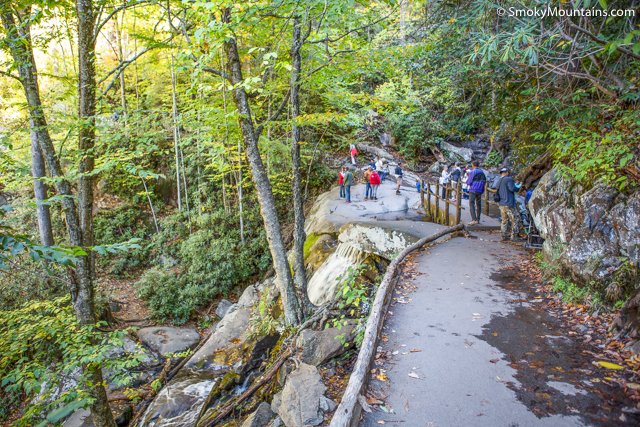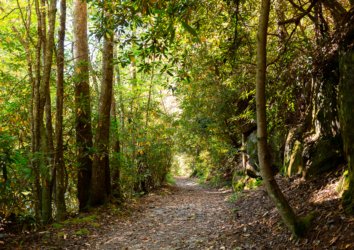Great Smoky Mountains National Park encompasses better than 800 miles of trails, offering some of the finest hiking in the country. And there’s truly something for everybody in this paradise of the Southern Appalachians: young and old. On the latter end of the spectrum, this most popular of America’s national parks certainly offers plenty of senior-friendly hikes.
Here are five of the best chosen for qualities such as shorter length, lesser difficulty, wheelchair-accessibility—and, of course, their Smoky Mountain beauty and ambience!
Laurel Falls Trail

This 2.6-mile round-trip hike is said to be the most popular in the national park. It’s also the longest of the park’s several paved footpaths. Tracing the racing course of the Laurel Branch, the trail reaches a big finish in the form of the 80-foot Laurel Falls: a double-decker horsetail falls ranking among the Great Smokies’ iconic landmarks. Hikers in May may enjoy blooms of the creek’s and trail’s namesake shrub, mountain laurel.
While it covers only a bit more than 300 feet of elevation gain, the tread on the Laurel Falls Trail is uneven and not suited to wheelchairs. You’ll expend some modest effort making the out-and-back, but the photogenic falls—and the up-close looks available from the bridge between the two drops—are well worth it.
Sugarlands Valley Nature Trail
This easy, half-mile trail along Newfound Gap Road, a stone’s throw from the Sugarlands Visitor Center, is nicely paved and wheelchair-accessible. Shadowing the West Prong of the Little Pigeon River, the Sugarlands Valley Nature Trail weaves through pretty forest scattered with interesting remnants of the historic Sugarland settlement, including stone walls and chimneys.
Keep your eyes on the nature trail’s pavement: A black bear that crossed the concrete not long after it’d been poured left behind unmistakable pawprints for posterity!
Clingmans Dome Observation Tower Trail

A short but rather steep paved path leads from the Clingmans Dome parking lot to the observation tower atop this loftiest summit of the Great Smokies, up at 6,643 feet. It’s a mile round-trip, and the trail—which is wheelchair-accessible—claims about a 13% grade.
The views from the observation tower are sublime: On clear days, the sightlines can stretch 100 miles or more. The panorama is arguably most all-around magnificent in fall, when vast reaches of autumn-colored forest roll away to all sides.
Gatlinburg Trail

The Gatlinburg Trail links the vicinity of the Sugarlands Visitor Center with the outskirts of Gatlinburg, the best-known gateway to Great Smoky Mountains National Park. Covering some 3.8 miles round-trip (though readily done as a one-way shuttle hike), this level footpath along the West Prong of the Little Pigeon River is an easy—and thoroughly pleasant—undertaking.
Enjoying the woods and the river, remember to keep your eyes peeled for bicyclists: The Gatlinburg Trail is one of only two in the park that allow bikes.
Porters Creek Trail

Senior hikers looking for a taste of the Smoky Mountain backcountry will enjoy the Porters Creek Trail, set in the history-drenched Greenbrier section of the park. This four-mile round-trip trail is moderately challenging with roughly 700 feet of elevation gain, so it’s best suited to older folks of decent fitness. It kicks off as an abandoned gravel road, then switches over to a dirt tread after about a mile.
The Porters Creek Trail reaches its dazzling peak in spring, when wildflowers of multiple species bloom along its way. Other attractions include some old-growth cove hardwood trees and such historic sites as the Ownby Cemetery and the 1875-built barn of the John Messer farm. The showstopper attraction, though—and the turnaround point for most hikers—is the roughly 60-foot cascades of Fern Branch Falls.
There’s No Age Limit When it Comes to Enjoying the Great Smoky Mountains
The above five by no means exhaust the possibilities of senior-suitable hiking trails in the Great Smoky Mountains National Park. Other fine destinations include Grotto Falls (off the Roaring Fork Motor Nature Trail), Spruce Flat Falls, and the Cove Hardwoods, Elkmont, and Spruce Fir nature trails. Naturally, many older hikers are still fully capable of tackling tougher, longer trails—indeed, some can impressively outpace younger (but perhaps less spry) companions! So use your best judgment when it comes to tackling more difficult routes.
And, of course, remember that the Great Smokies can be richly enjoyed off their many hiking trails as well, not least with scenic drives such as the Cades Cove Loop and Newfound Gap Road. So even older visitors with especially limited mobility can appreciate the splendor of these grand mountains firsthand.




